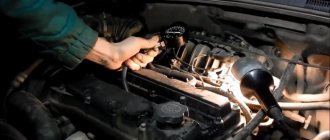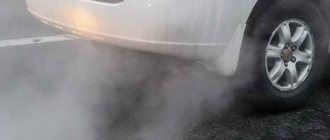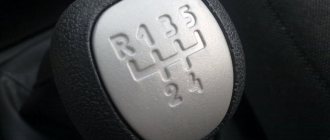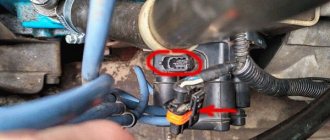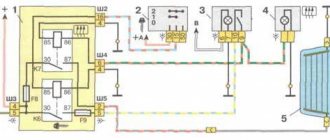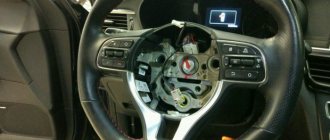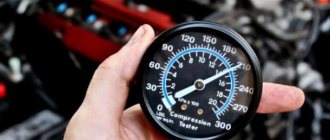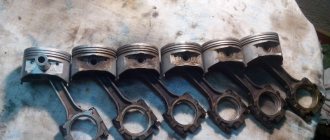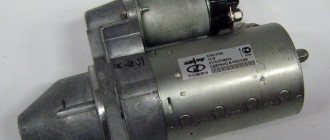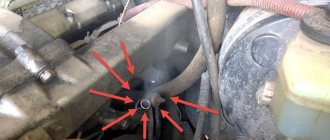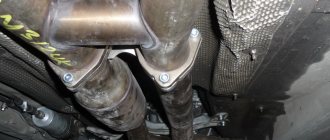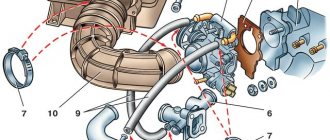20.09.2019
| (Votes: 1, Rating: 1) |
Issues discussed in the material:
- Why does the tire go flat?
- Is it possible to drive on a flat tire?
- How to fix a tire puncture
Although most modern cars are equipped with tubeless tires, every car owner can encounter a situation where tires go flat. This happens quite often, and measures should be taken immediately. In this article we’ll talk about why a tire gets flat and how to quickly deal with an unpleasant situation.
How to find and stop slow tire leaks?
If careful inspection of the flat tire does not reveal a puncture, the leak may likely be caused by a pinhole in the tread or sidewall. However, the problem may not be with the tire. The air valve stem may be leaking and will need to be replaced, otherwise the tire bead (where it meets the wheel) may be pressed tightly against the rim (a common problem in areas where road salt is used, which can corrode the metal surface).
Soap and water or water alone can help find the source of the leak. Mix liquid soap and water in a spray bottle. Spray all parts of the tire—tread, sidewalls, valve stem and bore (with the cap off), and along both sides of the rim—until you find the spot where the bubbles are. This is where the air comes out. This is easier to do with the wheel removed, but you might be able to find the leak without removing the wheel, especially at the front where turning the steering wheel exposes the inner sidewall somewhat.
Another method is to remove the wheel and immerse it in a bath of water. Bubbles form at the leak site. If the tub is not large enough to wet the entire tire, do the procedure several times.
Small punctures in the tread can be repaired. Large punctures may not, and minor damage to the sidewalls (where the tread and sidewall meet) will usually require tire replacement. Leaks and valve stems (the tiny valve itself inside the tube) can also be replaced.
If the leak occurs because the wheel is not completely seated against the tire, sometimes removing the tire and applying bead sealant can stop the leak.
Possible solutions for leaks originating from the wheel seat are to remove the tire, clean off the corrosion, and apply ball sealant before remounting the tire. Some mechanics also suggest inflating the tire with nitrogen instead of air because its molecules are larger than oxygen, potentially making them less able to slip through the smallest holes. This may be the answer since nitrogen contains less moisture - this will prevent rust if the wheel is made of steel.
When a wheel is leaking air, the question of whether it can be repaired or needs to be replaced will be decided. For example, pitting on a wheel can make the metal porous and allow air to leak out. This probably justifies the replacement.
Source
How to repair a tire puncture
Although repairs to tires damaged as a result of a puncture by a nail or self-tapping screw have been carried out for a long time, many car enthusiasts are surprised when, after removing the nail from the tire, they do not repair the puncture, but, on the contrary, enlarge it even further with the help of a thick file. When faced with repairing a rubber bladder with a tourniquet for the first time, you may experience some shock and doubts about the correctness of the specialists’ actions. However, the effectiveness of this repair method is much higher compared to installing patches. The rubber band used to retread a tire may be more durable than the tire itself.
In addition, this method of repair - with a tourniquet - has another undeniable advantage. They can repair the damage themselves. So don’t skimp and buy at least one tire repair kit. Using the fork-shaped awl included in the kit, you can return the wheel from which the air is being deflated to life.
However, in addition to the many advantages of repairing damaged tires with a tourniquet, this method also has a number of disadvantages. Please note that you cannot repair the sides of the camera yourself using the harness. The harness is glued to the walls of the tire, it is held on by them, but the sides of the tires are much thinner than those that are in contact with the road surface.
If you try to repair the side of the camera yourself, you may encounter a release of the harness in the future. But, most likely, you will initially not be able to remove the fork-shaped awl from the tire, designed to place the harness inside the wheel, without the harness itself. Also note that this method is used to eliminate damage caused by punctures; it is not suitable for more or less long cuts or lacerations.
In addition, it is not always easy to detect the puncture site; in most cases, it is possible to determine the damaged area by placing the wheel in water or treating it with a soap solution, which is not always easy to do in road conditions. If you come across a deep puddle, then, of course, you can try, but in this case you will not be able to do without an electric compressor, since during repairs a large amount of air will be released from the tire, and the harness must be inserted into the tire at operating pressure.
So, if you have already decided why the tire is flat and intend to repair it yourself using a harness, then the step-by-step instructions below will probably be useful to you.
- Determine the location of the damage. Inspect the tire carefully, most likely you will see something shiny in it - most often tires are damaged by glass, nails or screws.
Most likely you will notice, for example, a nail, but do not rush and immediately pull it out of the tire. Because in this case you can either damage the camera, or you will simply have to fully inflate the wheel. If you were unable to find the nail or other object that caused the puncture, be patient and look for the damaged area using other methods.
The wheel is running flat on the rim, what should I do?
This type of problem is relevant for tubeless tires and in places where the tire cord does not fit tightly to the car wheel, air escapes. For tubed wheels this problem is not relevant; they only deflate when punctured.
Some may wonder why everyone switched to tubeless tires, but they simply have more advantages over all other types
- Holds pressure longer
- They heat up less during long driving, since there is no friction between the tube and the tire. Without the use of a tube, the wheel is much lighter
- The puncture can be repaired right on the spot using a repair harness, or you can screw a self-tapping screw into the puncture site and drive to the nearest service station, which cannot be done on a tube tire.
- A puncture in a tubeless tire can be repaired many times faster than on a tube tire, since there is no need to put a patch on it, smear it with glue or wait for a long time to vulcanize at high temperatures. And in general, they are simply more reliable
Call a mobile tire service
Using the services of mobile tire fitting, you can count on help:
- tire or wheel repair;
- elimination of punctures and side cuts of any complexity
- installing a spare wheel instead of a damaged wheel;
- elimination of hernias and cones;
- pumping and balancing;
- editing disks;
- restoration of disks by welding in argon;
- removing wheel locks
If there is no spare tire available or repairing tires on site is impossible, mobile tire service employees can offer other ways to resolve the situation. For example, buy and install a new wheel. Or repair the tire in a workshop and deliver it back to the client.
Reasons why a tubeless tire goes flat
The main reason for the loose fit of the tire cord to the iron of the disk is either due to deformation of the disk itself - for example, it fell into a hole and bent the car disk, or due to the appearance of natural corrosion on the rim. Corrosion eats away small areas of the disk through which air subsequently manages to escape.
And as a result of this phenomenon, we are faced with the question of why the tire on the car went flat. This phenomenon also occurs over time due to natural wear and deformation of the tire.
The valve (valve for tubeless tires) poisons the air
photo: etrailer.com
Made from rubber, valves for tubeless tires can deteriorate over time. The rubber will harden and crack, reducing their tightness.
They can also be damaged by hitting a curb or other mechanical impacts (such as a car wash brush). Keep valve stems clean (do not lose caps).
Also, over-tightening the cap can damage the valve core. The valve may begin to bleed due to this.
My car has a flat tire, what should I do?
In order to overcome this disease, do the following:
- Bleed all the air from your car tire
- When bending the place where the cord meets the disk, lubricate this place with thick soapy water from laundry soap, not even water, but like a soap slurry, it should be so thick
- The second option is to lubricate it with paraffin candles, on average 3-4 candles will be needed for one tire, bend the cord and, pressing well on the candle, apply it along the entire diameter of the cord; paraffin should be poured generously onto the rim. When driving, the wax will begin to melt due to friction and will drown out the places where the air has been poisoned.
- You can also purchase special lubricants and sprays in the store to eliminate flat tires.
Well, if it’s drained and there’s no pump, then the only way out is to install a spare wheel or ask for help from passing cars, alternatively call a tow truck or call a friend. If you are completely stuck in the middle of nowhere where only one person a year passes by, then you can try to ride on a rim, yes, the tires will be ruined, but you will return, so to speak, to crowded places, where you can already solve this problem.
Repairing a tire using a harness
In addition to the tire inflation agent, it is advisable to put a tire repair kit in the trunk of your car. It will save you in case of a tire puncture. If you have such a “tire first aid kit” and the proper skills, it will take less than half an hour to repair a tire. The set consists of the following elements:
- An awl with a cut eye.
- Spiral shaped awl.
- Special tourniquet.
- Glue.
The repair operation is performed in the following sequence:
- The tire is inflated and the puncture location is determined. You need to inflate the tire not only to identify the problem area, but also for ease of repair.
- Now you need to carefully screw the spiral awl into the hole. It is necessary to develop a hole and prepare it for a tourniquet. To widen the hole, you need to insert and remove the awl several times.
- When the hole is ready, take an awl with an eye. A tourniquet up to 4 cm long is inserted into the eyelet so that the awl is in the middle.
- The awl with the tourniquet is carefully inserted into the hole until you feel that the bend of the tourniquet has reached the inner edge of the tire.
- All that remains is to sharply pull out the tool and cut off the excess pieces of the harness.
When the front wheel is punctured, this repair can be carried out without removing it. Just turn the steering wheel to the side and open access to the tire. But if the rear tire is flat, you still have to remove it. If after this operation the wheel maintains pressure, you can safely drive it to the service station. However, to be honest, most drivers have been driving such a wheel for several years and have no problems. A similar procedure can be done at a tire shop if the driver does not have time for more reliable repairs.
How to find out where a tire is flat
To do this, immerse the inflated wheel in water and see where the air bubbles appear. You can also make a soap solution and coat the wheel with it or apply it with a sprayer - where the bubbling soap foam appears there and poisons the air. Before these procedures, you should carefully inspect the entire tire yourself. you, where the nail sticks out and then the search for the broken place ends very quickly. Don’t forget to check the nipple or spool - often they can also be the culprits of a constant and systematic loss of pressure in the tires
Damage to the tire (it broke)
photo: reddit.com
A torn tire is unsafe, especially if the tear is on the side wall (a frequent occurrence when “grinding in” to a curb). Driving on a tire with a loose bead, even if the leak is minor, is dangerous! Couple that with an underinflated tire that can overheat, and you have a real explosive mixture!
Why does tire pressure drop?
As you read above, the reasons for this phenomenon are clear. But there are also cases like mine, for example, I installed new tires before winter and everything was ok, but after leaving the car in the garage for a couple of weeks and returning, I noticed that the rear right wheel was empty. I pumped it up, went to a friend’s service station, checked for a puncture, there was no puncture, it turned out that the car’s disk had slight corrosion and when it froze, the rubber contracted and hardened, and this small compression was enough to form a micro crack from which air came out at a rate of a bubble per minute , and in two weeks it all came out, as a result I have a flat tire.
How to determine the location of damage
Sometimes it is quite difficult to find out why a tire goes flat. And even experts sometimes become confused when they see that the tire is visually intact, but it does not hold air. There are at least several solutions to this problem. First, try pumping the wheel to 1-1.5 atmospheres and listen to where the air comes out. If that doesn't work, wet it with soapy water and find the place where air bubbles appear. If this does not help, submerge the wheel completely in water. It happens that a removed wheel holds air, but if you install it on a car, it leaks. In this case, you need to disassemble it and rub it over the inner surface of the tire with a rag. If there is even a small protruding object in the wheel, the rag will definitely get caught.
The tire goes flat on the side - solving the problem
What to do, a friend took the tire apart, sanded the rim at the contact point with sandpaper, lubricated it with some kind of German sealing grease for beading tires and put the tire back on - the result is that the tire hasn’t flattened for two months now. What follows from this is that a special sealant for tire rims provides the necessary sealing of the wheel rim with the tire, and also that in cold weather the rubber is subject to compression and additional deformation.
It follows that if a tire goes flat without a puncture, then the reason for this may be the physical properties of tires and wheels described above.
To top it off, I can only add that on the road, take with you an electric compressor for inflating tires and a set of repair harnesses, which can be very helpful; I have personally tested this more than once. Tell other car owners your methods of combating air leakage from under the tire cord.
Source
Overinflated tires
photo: www.smartmotorist.com
You are playing a dangerous game if you think that by inflating your tire to capacity you will increase the time between inflations. In addition to a rough, noisy ride, due to over-inflated tires, an over-inflated tire will begin to “eat the tread” faster, wear out and become unusable.
Plus, hard, overinflated tires are unstable while driving, lose traction more easily due to reduced tire-to-road contact area, and are easier to damage the sidewall cord. Due to excess pressure, the cord threads will break and a “hernia” may appear.
What did you experience?
The rest of the products involved in our examination will be conventionally called liquid. The composition must be injected into the damaged tire, after which it, coming out along with the air through the puncture, forms a sealed plug that prevents leakage.
In this examination, we decided not to compare drugs from different brands, but to show, using their example, different approaches to tire repair in the field. In company with a set of flagella ( "Hitchhiking AB‑1011"
) added a couple of aerosol products (
Aim One Tire inflator TI‑270
and
Hi-Gear HG5339
), as well as a composition in a soft bottle (
Hi-Gear HG5312)
and a product pumped into the tire when external pressure is applied (
Baseus Tire Repair Fluid
). In the photo gallery they are arranged in alphabetical order.
150 rub. Volume
ml not specified
Contents: awl, needle, glue, five self-vulcanizing strands
Repair kit for handy users. Capable of repairing fairly large punctures and cuts in tires - up to one and a half centimeters. When repairing small punctures, even the balancing is often not affected. For large cuts, you can push up to ten flagella to get to the tire shop.
390 rub. Mass/volume
300 g / 450 ml
It is recommended to immediately remove the item that caused the puncture. Does not require completely deflating the tire being repaired. For quick repairs, it will be useful for a driver who is not accustomed to servicing the car independently.
There are no Russian-language instructions. A compressor or pump will be needed not only to inflate a flat tire, but also to inject the drug into the tire. The final effect is almost no different from aerosol products, but surpasses them in price. A real plus: the cylinder is without pressure and will not explode in the heat. Rarely found on sale. And as our examination has shown, there is no need to specifically look for this drug.
The instructions are the most detailed in our selection. And the “correct” cap on the bottle: you can use it to turn out the spool valves! The product is recommended not only for repair, but also for prevention. When repairing, it is not necessary to remove the object lodged in the tire. It is stated that success is not guaranteed with side cuts. It is superior to aerosol products in terms of repair versatility (it also seals etching spools), but is inferior to them in ease of use.
Before repairing, it is recommended to eliminate the cause of the puncture. Like all aerosols, it does not require lowering the pressure to zero by unscrewing the valves. In terms of ease of use, like drug No. 2, it is the best in the sample.
What to do to prevent the problem
Any problem is much easier to prevent than to fix. As mentioned above, in most cases, a modern tubeless tire is punctured by a sharp object and does not immediately begin to deflate. To prevent the active phase of this deflation from taking place on the road when a protruding nail, for example, gets caught on something, you need to inspect the tires daily and measure the pressure in them at least once a week.
To avoid puncturing a tire, try to avoid dangerous areas (construction sites, old tram tracks, heavily broken roads, etc.). If it happens that you notice an obstacle, but do not have time to go around it, do not turn sharply. The central part of the wheel is much thicker and denser than the side, so it is better to drive straight towards the obstacle.
How to use?
In any case, you will need a compressor or pump to repair a flat tire. Even aerosol preparations will not be able to inflate the tire to normal.
When using aerosols (No. 2 and No. 5), as well as preparation No. 3, you do not need to unscrew the valve first. This means you don’t have to bleed the tire pressure to zero, which simplifies repairs. By the way, we measured the pressure developed by aerosol cans: it turned out to be from 2.4 bar for No. 5 to 3.2 bar for No. 2. And with sealing compounds in plastic bottles (No. 4), the valve must be unscrewed before repair.
Before using product No. 4, you do not have to remove the culprit of the puncture from the tire. This will not work with the rest: first you will have to remove the nail embedded in the tire and only then repair it. But which is better? On the one hand, a foreign object when moving can break the puncture site. And it is possible that after some time the tire will begin to leak air again. On the other hand, if the task is only to hobble to the service station, then the choice in favor of such a drug is obvious.
Tool No. 4 can be pumped into the wheel in advance! Then the car owner may not even know that he has “caught” a self-tapping screw: the viscous compound will quickly plug the hole that appears in the tire. It’s convenient, but at the same time the wheel will become heavier and will probably become unbalanced. By the way, don’t be surprised if, when disassembling the wheel, the tire shop will charge you extra money to remove the sticky mass. Cleaning it is oh so difficult.
Types of nipples
Such parts are produced not only for cars; factories also produce valves for:
- ordinary bicycles (Presta, also called French nipple);
- sports bikes (Woods).
The nipple for cars is considered the most universal and the most popular is Schrader. This device is wider than the model for sports bikes, but can be suitable for both regular bikes and mountain bikes. The part also has some disadvantages associated with operation.
On a car, the cap must always be screwed onto the clamp, otherwise dirt will clog it and further use will be impossible.
Another disadvantage is that a machine nipple holds pressure in the wheel worse than a bicycle nipple. But at the same time, the bike clamp is very fragile and can be easily broken if the tire is inflated carelessly. Most often, the head breaks off and the part becomes unusable.
The clamp model for sports bikes has some advantages over other types. A cap is already built into its design, but in this case, after inflating, it must be tightly tightened, as air leakage may occur.
The Presta tube nipple is easier to use as it can be used to inflate any tire. This is because there is no spring in the valve, and a tubeless valve does not require a very large wheel rim diameter.
On a note. The nipples can be short or long, so when inflating the tire you may need an additional adapter. This way you can lengthen the nipple. You just need to tighten the adapter piece well, otherwise air will leak when pumping.
Sometimes situations occur in which the thread of the wheel clamp is broken. Some car enthusiasts believe that this problem can be corrected with the help of taps. But this is not so, because the part has a far from unusual valve thread, which is equal to the following dimensions:
- outer diameter – 7.7 x 0.794 mm;
- internal hole – 5.3 x 0.7 mm.
Note! A standard thread cutting tool is not suitable in this case. Automotive nipple with thread
Automotive nipple with thread
Features of the drugs
The most unpleasant damage to a wheel is a side cut or hole of one and a half centimeters or more. In this case, liquid agents are a priori powerless. But flagella often help even with severe cuts. Of course, driving with a side cut even after repair is dangerous: drag yourself to the garage and urgently change the tire!
Sealants “work” only when the tire is damaged in the tread area. Air leaks through the nipple valves can only be eliminated by means No. 4.
Most liquid products contain water. Therefore, if you catch a nail in the cold, you will first have to warm up the product, for example, behind the bosom or near the heater deflectors. By the way, aerosols are also afraid of high temperatures - so do not leave them in the bright sun in the car - place them in the trunk of the car.
After using the medications, you should drive a couple of kilometers at low speed. The instructions say that in this case, the sealing fluid will spread evenly inside the tire without disturbing the balance of the wheel. This is wrong. A quarter of a century ago, our magazine proved in practice that all attempts to self-balance wheels with liquids poured inside end the same way: the tire has to be dismantled, cleaned from the inside and balanced in the traditional way. Keep this in mind when you pour sealant inside.
When filling the flat tire valve, it should be located below its center. By the way, the larger the size of the wheels, the more liquid sealant will be required: one bottle may not be enough to repair a puncture.
We recommend regularly monitoring the tire pressure for several days after repair. If it decreases, contact a workshop.
DIY repair
As practice shows, a car tire goes flat precisely at the moment when you do not have a spare tire with you (this is typical not only for beginners, but also for professionals). Therefore, carrying a spare tire with you is a rule that must be strictly observed.
In addition, you should get into the habit of inspecting the condition of your tires before and after your trip. This habit will save you time and money, and at the same time avoid serious damage to your car and threats to the health of you and your passengers.
If the tire does go flat on the highway, then you need to act quickly, but correctly! You need:
- inflate the wheel with a compressor or hand pump to 0.2 or 0.3 atmospheres;
- lift the car with a jack;
- carefully inspect the tire;
- If the damage cannot be immediately detected, spray the surface with a soap solution from a spray bottle.
The soap bubbles that form on the surface will indicate the exact location of the cut or hole. All that remains is to repair the damage in order to get to the tire repair shop.
You can repair a tubeless tire using a special first aid kit, which includes a spiral awl and a special needle; harnesses and glue.
Repairs must be carried out with the utmost care. The most difficult task is to correctly determine the angle of inclination of a hole or cut.
The repair procedure is as follows:
- carefully insert the awl into the puncture;
- Apply a layer of glue to the repair harness;
- remove the awl and quickly insert a tourniquet into the hole;
- use a spiral awl to push the tourniquet as deep as possible into the hole;
- then turn the awl 90° and carefully pull it out.
This repair method is good for repairing punctures with a diameter of more than 6 mm on the tread. Damaged tire sidewalls cannot be repaired this way due to the presence of highly loaded elements in the shoulder areas.
If the tire sidewalls are damaged, you will need the help of a car service specialist. It is also necessary if the hole is repaired and it is not possible to restore normal pressure in the chamber.
Damage to the wheel rim
Loss of air from a wheel most often occurs due to wear of the metal structure or incorrectly carried out beading of the wheels. For example, a workshop can save on the use of a special mastic that is used to coat the joints, which eliminates air etching. Therefore, you should not save on the services of tire workshops, entrusting such work exclusively to specialists who work in workshops that offer appropriate guarantees.
On old discs, metal fatigue is already observed, numerous defects appear on the rim, the entire internal structure loses its tightness, so even the use of special mastic will not help prevent air etching. In the future, such microdamages will only increase in size, and accordingly, the wheels lose air faster, resulting in the need for more frequent repairs or even changing the wheel.
Car owners often turn a blind eye to such air etching; it is easier for them to pump up the wheel once a week than to carry out expensive repairs or replace alloy wheels. However, in reality, incorrectly selected tire pressure negatively affects the vehicle's handling characteristics, causes increased tire wear, and also consumes more fuel, which increases the car owner's expenses. That is why it is still not recommended to operate a car on such old damaged rims, from which air leaks.
How to keep a car on the road in case of a sudden breakdown
There are times when a tire goes flat on the road for no reason at all. What should you do to stop your car safely? Let's look at it step by step:
- First of all, it is worth noting a simple fact - the slower a car drives, the greater the likelihood that its passengers will remain unharmed in the event of a sharp flat tire. Therefore, when breaking the speed limit, remember this.
- If a tire suddenly goes flat (you will certainly feel it), do not rush to press the brake to the floor. The subconscious will force you to slow down in any emergency situation, but this is the worst thing you can do in this case. If you brake, the car will pull even more.
- If you have cruise control on, turn it off as quickly as possible.
- Do everything to keep the car on a straight path. If it pulls to the side, turn the steering wheel in the opposite direction. But don't overdo it, otherwise it will have the opposite effect.
- Let the car drive itself to the stopping place. The car will brake on its own due to a flat tire. You can help her by lightly pressing the brake. In this case, it is best to brake using the transmission. If there is no shoulder nearby, do not stop on the road; it is better to drive some distance. Be sure to turn on your hazard lights so other participants are aware of your problem and be careful.
Why does it descend if there is no damage?
Nipple failure
You can also detect a deflated wheel when the rubber does not adhere well to the rim of the disk. This means that grains of sand or something small have penetrated between them, for example, corrosion of the wheel rim itself. Here you need to inflate the “injured” wheel and visit a tire shop, because the tire will continue to deflate until the specialists straighten the wheel. In addition, the same problem can develop because the product was not stored correctly, and the rubber “glassed” slightly.
Air also leaves the rubber if the nipple element breaks. If the nipple element is simply wetted with saliva and at the same time you find that the surface is bubbling, this means that it should be urgently replaced. Car service technicians will help you replace the nipple, but with experience, you can actually carry out this simple work yourself. In this case you need to prepare:
- key for unscrewing the nipple;
- new nipple element;
- compressor device.
A tire without a tube can easily deflate at low temperatures, this is explained by the fact that even expensive types of tires harden during frosts, and this provokes a loss of seal.
It is enough to heat the tire and the problem will be eliminated. However, this, of course, is not a solution, you should visit a tire shop, and the technician will remove the tire from the rim, coat the rim with a sealing substance and perform the assembly, then the problem will be resolved, the tire will stop deflating.
